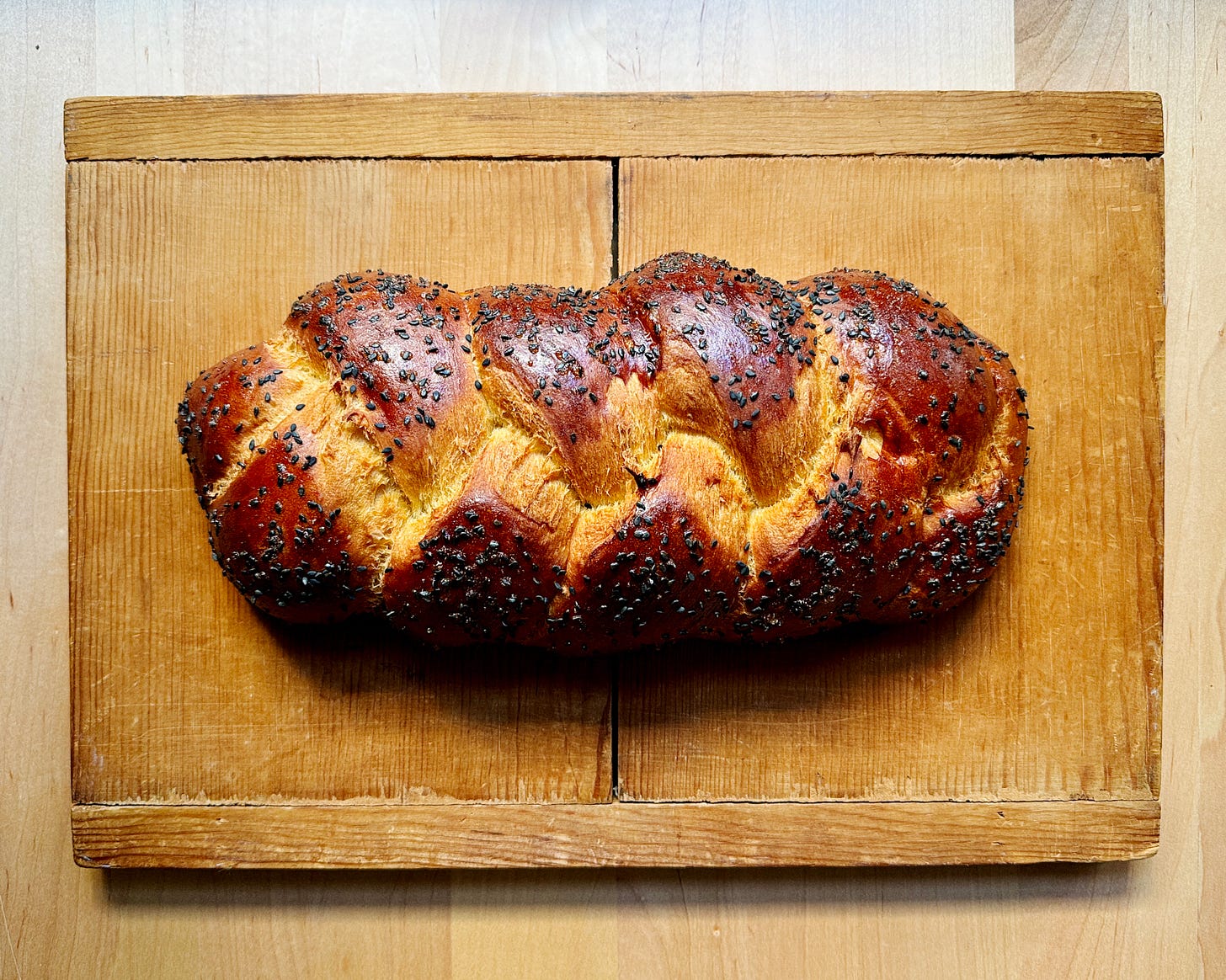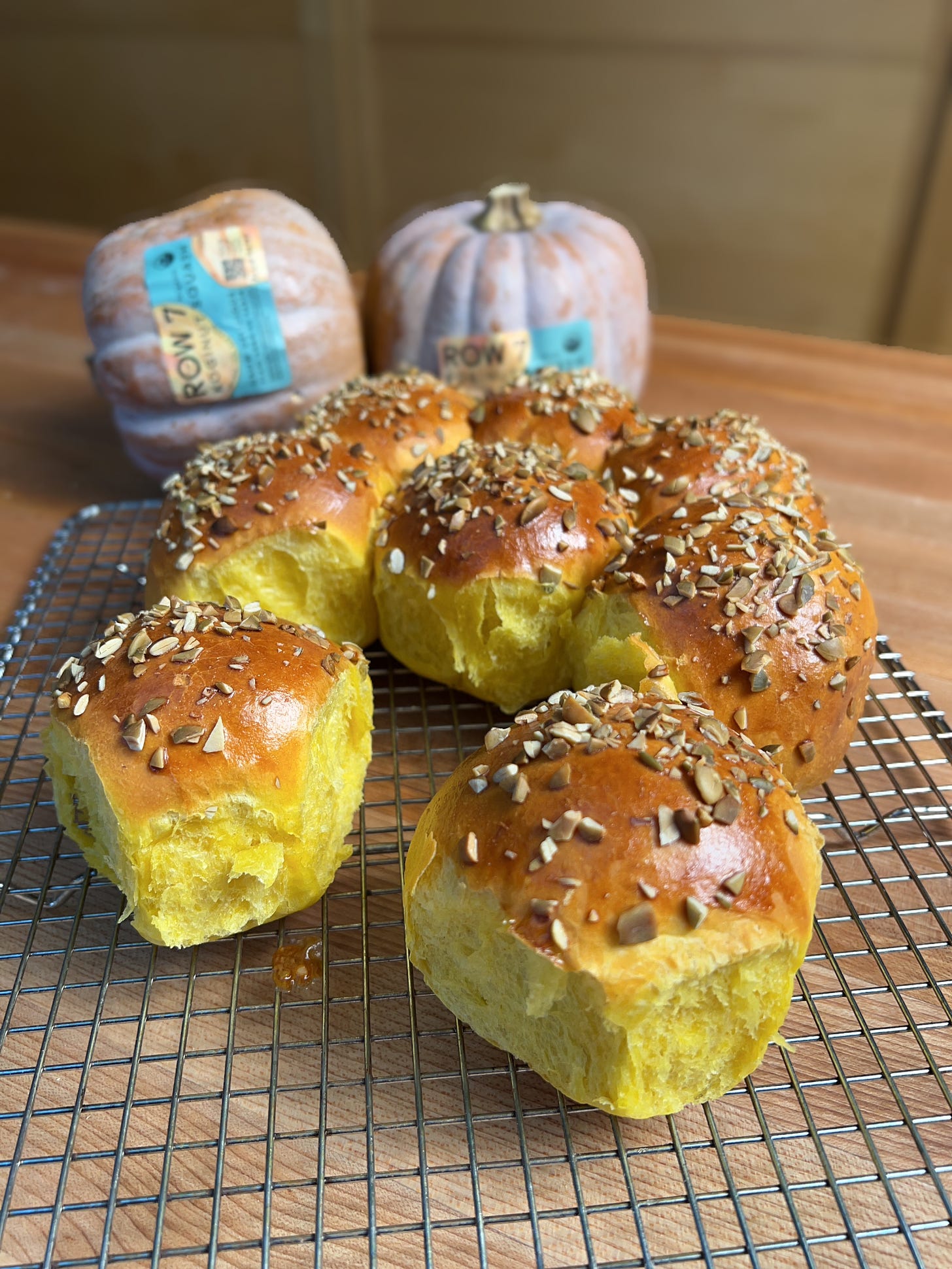Lifestyles of the Enriched and Famous, Part Three
On enriched breads and their ingredients—Fats
This is post three in a multi-part series on the many ingredients that go into enriched breads. (The first post, on eggs, is here, and the second, on milk and other liquid dairy products, is here.) Today is all about fats, without which an enriched bread isn’t really enriched.
Fats and oils
Fats (lipids) like butter and oil in a bread promote a fine crumb and a decreased loaf volume. Though the term “shortening” predates the understanding of the phenomenon (it referred originally to the crumbly texture of baked goods made with large amounts of fats, of which shortbreads are the type specimen), fats do this so by limiting the ability of gluten units from linking together into wider networks, keeping gluten strands “short.”
Fats also act as plasticizers in both doughs and baked goods, since unlike starch and gluten, they do not firm up upon baking, leaving the texture inside and out soft and flexible. Fats also slow down staling, by limiting the ability of water to migrate out of starches, stabilizing their gelatinized form, which keeps breads softer longer.
Neutral fats give breads generic richness, while flavorful ones like butter or lard bring their own character to the bread as well. And fats also disperse flavorings added to breads—like herbs and spices—many of which contain compounds that are exclusively fat-soluble.
Flavorful fats like butter and olive oil obviously add their own distinctive character to bread, but in my experience they have to be used in relatively high amounts—10% or more—for the flavor to be discernible in the finished product. For this reason, if a recipe calls for say 5% olive oil, a neutral vegetable oil will work and taste identically. (I often call for olive oil in recipes where it is traditional, like focaccia, but its use is not essential.) Toasted nut and seed oils can shine through in relatively small amounts; one of my favorite focaccia formulas uses 3% toasted sesame oil in place of olive oil, and it is very aromatic.
In small amounts (up to 5% or so), fats behave more or less similar to water in a dough. Which means that if you add fat to a formula, you'll want to decrease the amount of water by an identical amount to keep the consistency of the dough similar. But because fats interfere with gluten formation, you'll likely need to make other adjustments to accommodate amounts significantly greater than 5% (like using a stronger flour, a dough strengthener like ascorbic acid, or increased mixing times).
Solid fats
“Solid” fats like butter, lard—and refined coconut oil, my current go-to vegan butter substitute—have a low melting point, which makes them crystalline at temperatures below about 70˚F (21˚C).
This is the main reason many bakers (myself included) chill their butter-enriched doughs before shaping them, since it firms them up, making them far easier to handle, even when sticky at room temperature. (Even an oil-containing dough will firm up when chilled, but not quite as much as those with solid fats in them.) A firm dough is also slower to ferment, which explains why enriched doughs can be retarded for longer durations than lean ones without overproofing.
Conversely, the more fat in the dough, the warmer the final proof needs to be to overcome this effect; for this reason, I tend to do the final proof of my yeasted enriched loaves at 80˚F (26˚C) and sourdough ones at 85˚F (29˚C). (This also helps “wake up” the yeast after the dough’s stay in the fridge.)
Butter
Butter contains about 80% fat. (In North America, at least; European butters can be as high as 86% butterfat.) The remainder includes water (16-18%) and milk solids (~5%; proteins, lactose, and minerals). Most bakers use unsalted butter for baking, because the salt content of salted butter is highly variable, which makes controlling the salt content of a dough challenging. (The water content of salted butters is also variable, another reason to avoid them.)
The primary benefits of butter over other fats are its distinctive flavor and its low melting point, which makes doughs firm when cold and gives butter-enriched breads a richer mouthfeel (they literally melt in your mouth). The milk solids in butter do promote browning and tenderness in bread, but their concentration is low enough that most enriched breads include milk as well, to increase these effects further.
When substituting oil for butter in a formula, you'll likely want to account for the water in the butter by decreasing the amount of fat by 20% and adding water to make up the difference. (And to replace oil with butter, increase the amount by 20% and reduce the water by the that amount.)
While butter's flavor in breads only comes through when used in relatively large amounts, browned butter can provide nutty flavors, even when used in small amounts, much like toasted nut and seed oils do. Remember to add back the water lost during browning (~17% of its original weight), to keep the dough consistency the same.
Melted vs. softened butter for enriched breads
Most classic recipes for enriched breads (brioche, especially) have you add softened, but still crystalline, butter to the dough, usually after full or partial dough development. As I’ve mentioned already, I use melted butter in mine, and I’ve not found any downsides to doing so. The idea behind this is that keeping the butter in its “crystallized” form has an impact on the dough or loaf, but I’m not sure exactly what doing so is meant to either avoid or produce. Given that doughs proof at temperatures at or above the melting point of butter, it’s unlikely that structure survives in the dough anyway. Since most of my enriched formulas include a scald, I usually just let the butter cool down the scald, while melting into it, and it works fine.
Refined coconut oil
I’m still working on my vegan brioche formula for Breaducation, but I think know what fat I am using to replace the butter: refined coconut oil, since it too is solid below 70˚F, and it is easy to come by. (Unrefined coconut oil has a strong flavor, so don’t use that unless you are going for a “coconut” bread. Which might be nice…) In small amounts (up to 10%), it works similarly to butter. In higher amounts, however, it can make chilled doughs too slow to ferment and too firm to shape when cold. (Advice here forthcoming, since I’m not sure yet how to address this. Most likely it will involve letting the dough proof longer at room temperature in bulk and sit out at room temperature for a while before beginning to shape it.)
I’ve seen vegan enriched breads that use cocoa butter as a butter replacement and I may test it. But it is much more expensive than coconut oil, harder to find, and is much firmer than butter when chilled, so I am unlikely to call for it.
That’s all I have to say about fats in enriched breads. Anyone have any thoughts or questions of their own?
—Andrew





these posts are all so good, and i'm waiting by the phone for your vegan brioche! (was just just scrolling through brioche feuilletée recipes this morning and thinking, "if i just had a good vegan brioche..."
Cocoa butter with added liquid is superior to coconut oil texture wise. And definitely taste. Won’t last more than 24 hours unless you refrigerate and steam as needed. 5 days in that case.